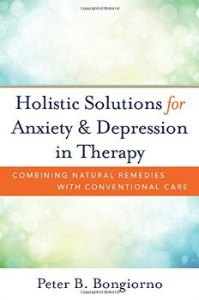
Book Review: Holistic Solutions for Anxiety and Depression in Therapy by Peter Bongiorno
Written by Craig Rogers, Posted on , in Section Mental Wellness
Original book review first appeared on Psych Central February 17th, 2016 by Megan Riddle
Dr. Peter Bongiorno graduated from Bastyr University, the leading accredited university for science-based natural medicine. He completed five years of training in naturopathic medicine and acupuncture, and was honored to be his class speaker.
“It is more important to know what sort of person has a disease than to know what sort of disease a person has.” — Hippocrates (460-377 B.C.E.)
“The art of healing comes from nature and not from the physician. Therefore, the physician must start from nature with an open mind.” — Paracelsus (1493 – 1541)
Treatment options that have long been considered outside the mainstream are becoming commonplace: a survey shows that nearly two in five adults in the United States have tried complementary or alternative therapy in the last year. As clinicians, it is our job to work with the individual to find the best treatment, whether that is Prozac or folate, light therapy or cognitive behavioral therapy. Each individual is unique, and treatments should be as well.
In Holistic Solutions for Anxiety & Depression in Therapy: Combining Natural Remedies with Conventional Care, Peter Bongiorno offers a comprehensive overview of options for treatment of anxiety and depression.
Bongiorno is a doctor of naturopathic medicine and currently vice president of the New York Association of Naturopathic Physicians. This is only the most recent in a series of books he has authored; others include Healing Depression: Integrated Naturopathic and Conventional Treatments and How Come They’re Happy and I’m Not? In his latest, he walks the practitioner through the many components of naturopathic therapy, but stays accessible for readers interested in using complementary and alternative medicine (CAM) themselves.
“All practitioners working with anxiety and depression should note that, overall, patients generally do their best with the treatment they choose and believe in, whatever that may be,” Bongiorno writes. By working with the individual, rather than just writing a script that may never be filled, we have a much better chance of helping that person find a path of wellness.
Bongiorno lays out when he believes CAM treatment is appropriate (most cases) and when more traditional treatment may be a better option, at least initially (e.g., in cases of severe depression or incapacitating anxiety). When CAM therapy is not able to be used as the first-line treatment, he endorses a team approach, writing that “team management by the patient’s prescribing doctor, therapist, and CAM provider … will afford the best overall care and allow for comanagement needed to consider future discontinuation of medications when appropriate.” It is with this balanced outlook that he engages readers.
After going over who should consider CAM, Bongiorno delves into a discussion of underlying causes of depression and anxiety, encouraging the examination of both external and internal factors. He explores things like sleep, diet, and sunlight and blood sugar, thyroid function, and the hypothalamic-pituitary-adrenal axis. Throughout, he offers guidance on how to improve issues, such as steps for ensuring a healthy digestive tract and reducing inflammation. He then discusses supplement options that target anxiety and depression, including possible benefits and risks for each.
To continue reading this book review click on "Next Page" below.
